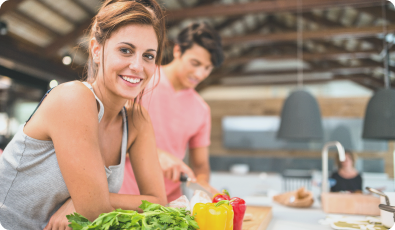Surprises sharpen our brains and keep us on our toes.
Sometimes they appear at random without any input from us and sometimes we have to actively seek out a way to surprise ourselves or force us out of the normal routine.
It doesn’t have to take much effort to shake things up a little bit and it’s a great way to keep your life interesting, enjoyable and, yes, surprising.
So too, can your diet remain surprising. It doesn’t have to be stuck in a pattern where you’re eating the same food day after day. My program is about opening up the food possibilities. Sure, we limit the unhealthy ones but the door opens wide to vegetables you have never considered and walked past at the green grocer’s.
Centuries ago there were 500 different plant foods in our diet. Now, even the healthiest diets tend to be based on about 15 plant foods that we swap around from week to week. Or maybe we just eat the same five vegetables every day of our lives, in the same way with the same results. Given that so many of our nutrients come from plant foods, we may have to set about exploring them a bit more because the surprises won’t just land on our doorstep.
It’s about diversity.
I know we’re busy. Our brain is even busier. We have a tried and true food repertoire of favourite things but there are great benefits to doing a taste test every now and then to awaken your palette to new flavours.
Start by going to some new food stores. You’ll be surprised how different the selections are even between the two major supermarket chains.
Then, look at different recipes for ideas to adapt or build upon. Be inspired by seasonal foods. This is where a lot of allergies develop – we source food from all parts of the world rather than focusing on fresh, local, seasonal food.
If you enter the fresh fruit and vegetable section of the supermarket you’d be forgiven for not knowing which foods were seasonal because they’re mostly all available to purchase but look for the most abundant foods. As soon as the season for stone fruit hits, there is a bigger supply of peaches and plums and they will lower in price as the season reaches its peak. Don’t be tempted into trying the tiny little tray of peaches from Mexico that are as hard as rocks and taste terrible because they have been transported in cold storage, well out of season.
You can always try asking your green grocer what is in season. They are only too happy to share the knowledge they have spent their lives gathering about which are the best foods to buy and when because it will always be at its best when it’s in season.
Variety is the spice of life and it’s crucial for health as well.
I once had a client who achieved great results and I could hardly fault her diet diary that she presented to me when she reached a plateau. The only problem was that she had the same meals every day. The same breakfast, lunch and dinner. Her body was as bored as she was with the menu she was sticking to, believing it was still serving all of her needs but she was scared to diversify.
If you want to have a salad, fill it with 10 different ingredients, not just some iceberg lettuce and a few wedges of tomato. When I’m cooking, my kitchen bench is full of different vegetables before I even start to throw in the herbs and spices. The more colour you can find, the better because that also means you’ll be boosting your nutrient load and particularly your fibre load.
Diet experts commonly refer now to a food pattern rather than individual foods or ingredients because foods need each other to activate their nutrients. They all bring out the best in each other, to our benefit. The Mediterranean diet, for example, is a food pattern that is filled with a rich variety of foods and nutritionists don’t just select some key elements of the diet such as olive oil or fish as being the superfood. It’s a rich matrix of foods that is filled with variety.
If it seems too confronting to buy up big at the food store, start slowly and just add one or two new vegetables at every shop. Perhaps you’ve grown up eating certain foods and you don’t venture away from them, especially if you have to cook them for yourself.
I was raised on vegetables that were cooked in salted water until they were so soggy they had neither texture nor flavour. It was certainly a way to give vegetables a bad name. But as my mother was preparing the evening meal, I’d often grab them before they met their fate in the dreaded salty water. I loved eating raw vegetables. A world of flavour opened up to me and it wasn’t until I started cooking for myself that I realised they could retain much of that flavour if they weren’t overcooked.
My dear mother had the same approach with meat. She’d buy expensive cuts but then cook it until it was a drab shade of grey and had the texture of shoe leather.
That’s the diet I was raised on but I changed it to suit my own tastes and in accordance with my knowledge about nutrition. Some people don’t make that change and believe the only way to cook is to follow the diet they grew up on, when we know a lot more about food now and particularly food preparation.
A lot of my clients say their taste buds wake up to flavour in a whole new way when they’re on my program and their fridge is filled with a great variety of foods. In fact their taste buds change permanently when they correct their gut biome because a healthy gut tells the brain what foods it favours.
























